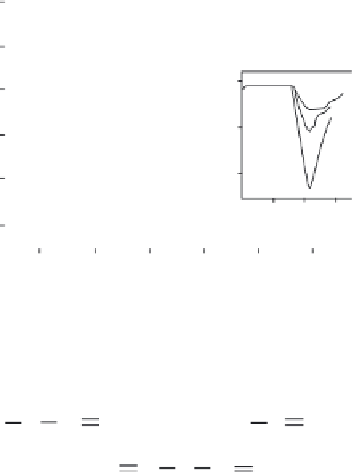Biomedical Engineering Reference
In-Depth Information
2.0
1.8
0
1.6
c
b
100
1.4
200
1.2
a
40
120
Time/sec
80
0
1.0
8.8
8.4
8.0
7.6
7.2
6.8
Log [sulfotep] / M
FIGURE 2.7
Logarithmic plot of
I
% vs sulfotep concentration for fl ow-injection detection. Inset: amper-
ometric responses at (a) 0, (b) 20, and (c) 50 nM sulfotep [11].
Phosphorylated enzyme
Oxime
CHR
(
O)
Enzyme
O
P
(R
1
)(OR
2
)
O
N
Phosphorylated oxime
Reactivated
(
O)
Enzyme
CHR
N
O
P
(R
1
) (
OR
2
)
FIGURE 2.8
Mechanism for inhibited enzyme reactivation using oxime.
2.3.5 Enzyme reactivation
The reactivation of inhibited enzyme is highly desirable for the repeated use of FIA.
Wilson and his colleague [60] reported a classic study and demonstrated that strong
nucleophiles such as oximes could reactivate organophosphatecholiesterase complex to
give rise to free enzyme. Various oximes have been used as reactivators for cholineste-
rase inhibition [61, 62]. Figure 2.8 shows the reactivation mechanism. One of the
limitations in use of oximes is the relatively slow rate of reactivation. Of concern to
pesticide biosensors, 2-pyridinealdoxime methiodide and 2-pyridinealdoxime meth-
ochloride have been widely employed as reactivators for continuous monitoring of the
OPPs [11, 61]. Dioximes such as 1,1
-trimethylene bis 4-formylpyridinium bromide
dioxime (TMB-4) have been also employed as reactivators, particularly under condi-
tions of exposure of the enzyme to higher pesticide concentrations. TMB-4 performs a
more effective reactivation of the immobilized AChE inhibited by the paraoxon than 2-
pyridinealdoxime methiodide [62]. The reactivation % and stability of enzyme depend
on the degree of inhibition and type of pesticide.
2.4 PESTICIDE IMMUNOSENSORS
An antibody can recognize an antigen in particular even in the presence of structurally
close or related compounds. Hence antibodies have been used as potential recognition

















Search WWH ::

Custom Search